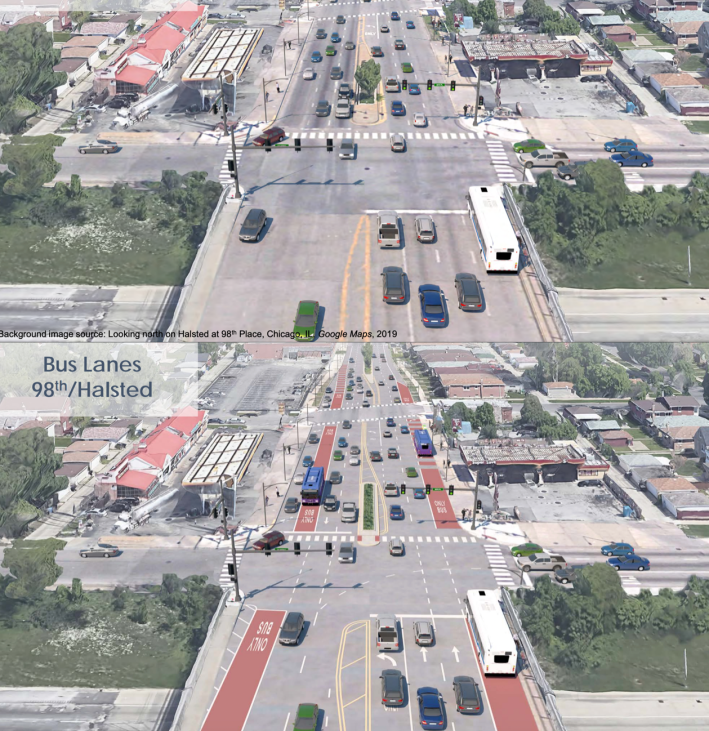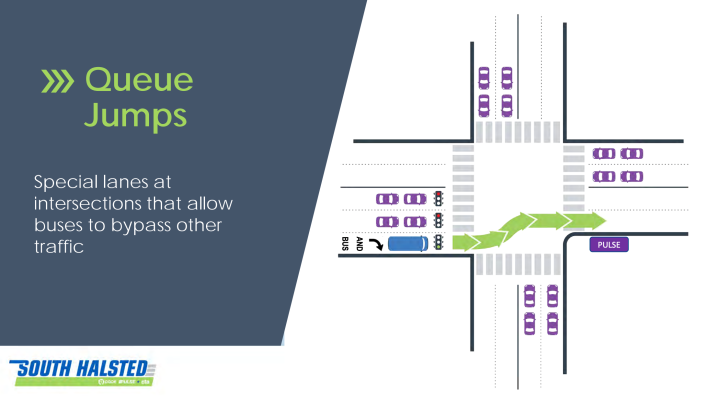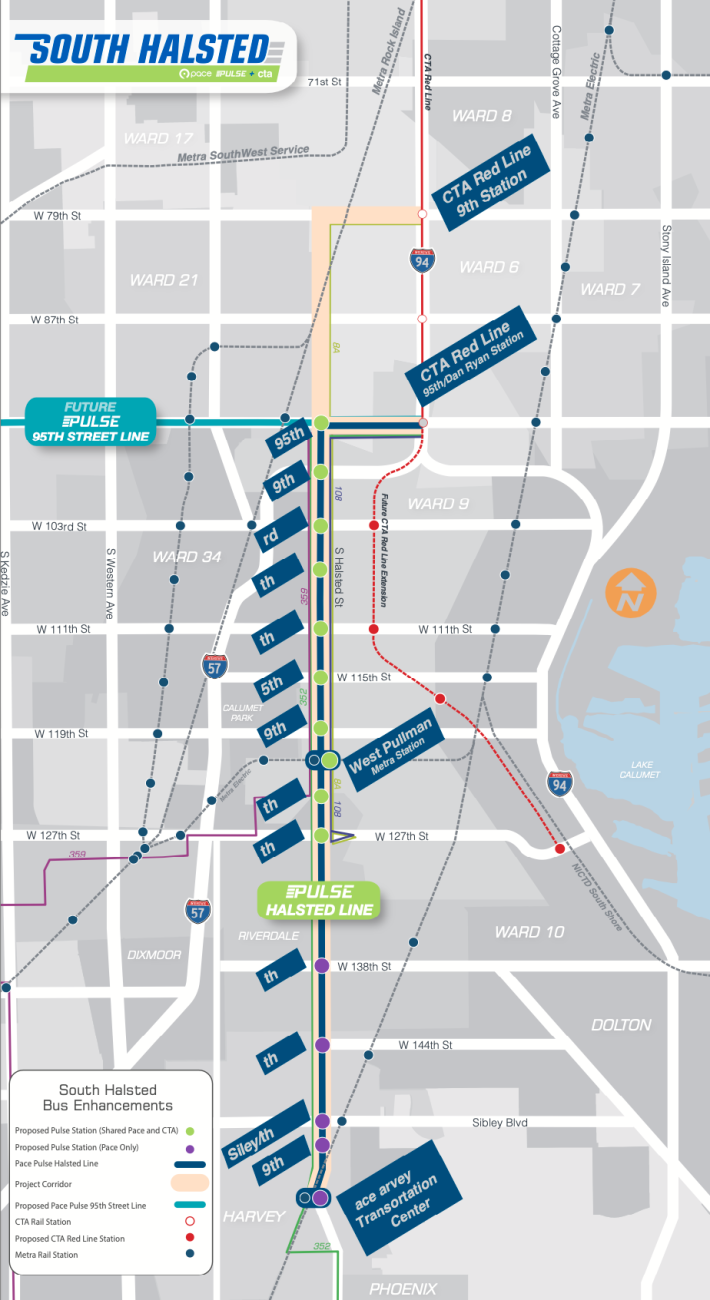Sadly the plan for Pace's Pulse South Halsted Arterial Rapid Transit bus line no longer includes significant stretches of dedicated bus lanes, which means transit riders will continue to get stuck in car-driver-generated traffic jams, despite the fact this stretch of Halsted is a wide, multi-lane street.
Bus lanes were largely stripped from the proposal after local residents and politicians complained that the proposed layout would eliminate on-street parking spaces. In a follow-up analysis done in the response to this feedback, Pace found that, in many stretches of Halsted, converting the parking lane wouldn’t have provided enough right-of-way for bus lanes anyway. There were also legitimate concerns about the new street design eliminating some median plants and narrowing sidewalks in some locations.
The suburban bus agency is developing the Pulse bus line network to improve service along some of its busiest corridors. Pace Route 352 currently serves much of Halsted Street in southern Cook County, running between the 95th/Dan Ryan Red Line station, the Harvey Transportation Center and the Chicago Heights Transportation Center. The Pulse Halsted line will follow the route between 95th/Dan Ryan and Harvey, the busiest part of the route.
To shorten trip times, the Pulse buses will only make 14 stops at major intersections and destinations along the 8.5-mile route. Route 352 will continue operating service with all the current stops, with 95th/Dan Ryan to Chicago Heights service remaining largely the same, but the Pulse route would replace the Harvey trips. The planning for Pulse Halsted is being done in tandem with the CTA’s efforts to improve bus service along the portion of Halsted Street between 79th and 127th streets, since Pace and CTA service overlaps between 95th and 127th streets.
During the first public meeting on the project, which was held in January 2020, Pace representatives revealed that the Pulse Halsted proposal would include dedicated bus lanes on a significant portion of the route. But the negative feedback the planners heard at that hearing caused them to scrap that idea. During the second public hearing earlier this month, Pace reps explained that they were only going to create dedicated bus lanes on the busiest stretches of the corridor, and rely on transit-priority traffic signals and passing lanes to speed up service on other sections, the way it plans to do on other Pulse lines that lack dedicated lanes.
Pace currently expects the final design will be completed in 2023, with construction starting in 2024 and wrapping up over the next year or two.
Overview of bus routes along Halsted Street
Route 352 has been Pace’s busiest route, even during the pandemic. The 95th/Dan Ryan to Harvey portion of the route is the only part of the Pace network that runs 24/7, other than night shift service to UPS facilities. Until 2021, only about one-third of all trips went past Harvey Transportation Center, but improvements to Halsted service made in conjunction with the Fair Transit South Cook reduced Metra fare pilot significantly increased service to Chicago Heights, especially on weekdays. The route connects several regional hubs on the South Side and the suburbs, and riders can transfer to Metra Electric Line’s main and Blue Island branches at the Harvey Transportation Center and 120th Street, respectively.
While the CTA spent the past 15 years cutting or restructuring much of its service that overlapped with Pace, the Halsted Street corridor is one of the exceptions. CTA route 8A South Halsted serves Halsted from 79th Street to Vermont Street near the city limits, while the CTA's 108 Halsted/95th bus follows the same itinerary as Route 352 as far as 127th Street, before going express to Carver High School in the Altgeld Gardens housing project further east. Pace’s Route 359 follows the same path as Route 352 as far as 124th Street before heading southwest, although it runs express between 119th Street and 95th/Dan Ryan, so there isn’t much service duplication.
During the May 2020 meeting, the CTA’s chief planner Mike Connelly said, “The buses on South Hasted provide critical transit service for Chicagoans who commute to destinations beyond the Far South Side," the CTA’s and Pace's research found that these bus riders' commuting times are 20 percent longer than they are for an average Cook County commuter.
Pace executive director Melinda Metzger said improving service for the majority-Black Far South Side and suburban Southland communities would help make the suburban bus transit more equitable. She also noted that the line would complement Pace’s efforts to add new express service along the Tri-State Tollway.
The new plans
Charlotte Obodzinski, the Pulse Halsted project manager, said that, after the January 2020 meeting, Pace met met with local elected officials, who said, while they were generally supportive of the project, they had concerns about how it would impact roads and sidewalks. “Additionally, the Chicago Department of Transportation encouraged us to find solutions to support the surrounding communities and not just people driving through there, to ensure that sidewalks [aren’t too narrow.]"
That led Pace and the CTA to do another study. Project consultant Steve Brown said a topographical survey made them realize that they didn’t have as much room to work with as they previously thought. “In order to run continuous bus lanes in both directions, we'd either have widen the road and make sidewalks narrower, or we'd have to cut into the medians,” he said, adding that they’d have to widen the intersections, “which is worst place to do it” because it would make the distance pedestrians have to cross longer and less safe. Of course, another alternative that Brown didn't mention would be to convert existing mixed-traffic lanes to bus lanes.

Obodzinski added that the project team found that simply converting a parking lane wouldn't provide enough right-of-way for the bus lanes, unless the sidewalk was narrowed. The parking lane ranged from 7-8 feet, but bus lanes would require at least 10 feet, preferably 11 feet. "Based on the community feedback, [eliminating parking and narrowing the sidewalk] was not something that people were very excited about.”
As the result, the planners decided to water down the plan by only installing full bus lanes at the I-57 bridge near 98th Street, where there are a whopping seven lanes to work with. Queue jumps – short bus lanes at intersections buses can use to get around drivers – will be added at the intersections where the study found traffic tends to slow down the most. That includes Halsted's 95th, 103rd, 111th, 114th/115th and 119th street intersections. For the Route 8A-only section, they will put in 1.5 blocks of bus lane at the spot where Rock Island District line embankment passes over Halsted, and queue jumps at the three-way 87th/Vincennes/Halsted intersection and the 79th/Vincennes junction.

Brown said the buses will get transit signal priority if the traffic conditions justify it. And he said that, since the suburban section of line is already narrower and less busy, they didn’t see the need for bus lanes on that stretch.
The stops will be similar to the existing ones on the Pulse Milwaukee corridor, with raised platforms to make boarding easier, bus shelters with heat lamps and bus tracker displays. Brown said the project also includes improvements to nearby sidewalks and crosswalks.

During the public comments portion of the hearing, several attendees expressed concern about security on the buses. “Have you all considered the safety issues that the operators may incur as we move deeper into the city of Chicago, seeing that Pace has no security [guards] for their employees?” asked Alondra Willis, a Pace bus driver and president of Amalgamated Transit Union Local 1028.
Metzger acknowledged that Pace doesn’t use security guards of its own, but she said that bus drivers can call their dispatcher or hit the panic button if case of trouble.
CTA government affairs specialist Ashley Walker said that the agency is beefing up security. “We do have private security that we have deployed out onto our stations, and also our buses. We are limited to what we can [do as far as] safety, because safety and security ultimately falls to the [Chicago Police Department.]”
While it's unfortunate that the Pulse Halsted plan no longer includes significant stretches of bus lanes, hopefully the other time-saving features will help shorten trips for South Side and Southland commuters.






